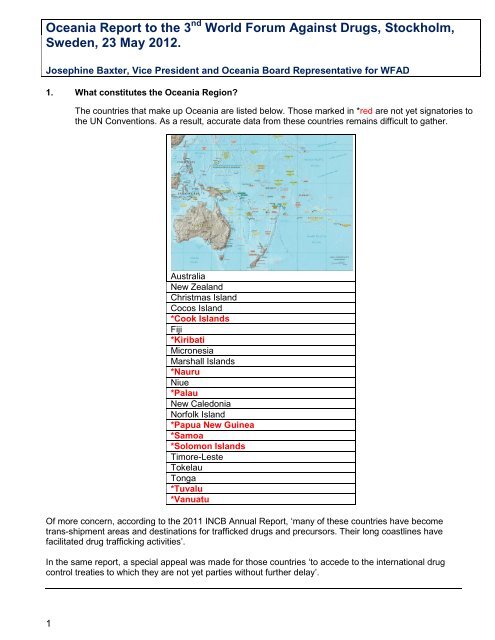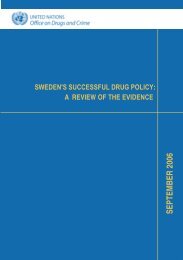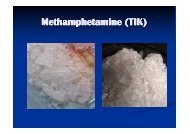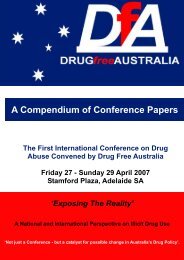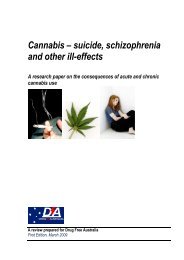Oceania Report to the 3 - Drug Free Australia
Oceania Report to the 3 - Drug Free Australia
Oceania Report to the 3 - Drug Free Australia
Create successful ePaper yourself
Turn your PDF publications into a flip-book with our unique Google optimized e-Paper software.
<strong>Oceania</strong> <strong>Report</strong> <strong>to</strong> <strong>the</strong> 3 nd World Forum Against <strong>Drug</strong>s, S<strong>to</strong>ckholm,<br />
Sweden, 23 May 2012.<br />
Josephine Baxter, Vice President and <strong>Oceania</strong> Board Representative for WFAD<br />
1. What constitutes <strong>the</strong> <strong>Oceania</strong> Region<br />
The countries that make up <strong>Oceania</strong> are listed below. Those marked in *red are not yet signa<strong>to</strong>ries <strong>to</strong><br />
<strong>the</strong> UN Conventions. As a result, accurate data from <strong>the</strong>se countries remains difficult <strong>to</strong> ga<strong>the</strong>r.<br />
<strong>Australia</strong><br />
New Zealand<br />
Christmas Island<br />
Cocos Island<br />
*Cook Islands<br />
Fiji<br />
*Kiribati<br />
Micronesia<br />
Marshall Islands<br />
*Nauru<br />
Niue<br />
*Palau<br />
New Caledonia<br />
Norfolk Island<br />
*Papua New Guinea<br />
*Samoa<br />
*Solomon Islands<br />
Timore-Leste<br />
Tokelau<br />
Tonga<br />
*Tuvalu<br />
*Vanuatu<br />
Of more concern, according <strong>to</strong> <strong>the</strong> 2011 INCB Annual <strong>Report</strong>, ‘many of <strong>the</strong>se countries have become<br />
trans-shipment areas and destinations for trafficked drugs and precursors. Their long coastlines have<br />
facilitated drug trafficking activities’.<br />
In <strong>the</strong> same report, a special appeal was made for those countries ‘<strong>to</strong> accede <strong>to</strong> <strong>the</strong> international drug<br />
control treaties <strong>to</strong> which <strong>the</strong>y are not yet parties without fur<strong>the</strong>r delay’.<br />
1
2. Concerning trends in <strong>Australia</strong> and New Zealand:<br />
<strong>Australia</strong> and New Zealand remain <strong>the</strong> highest per capita in illicit drug use in <strong>the</strong> developed world. The<br />
following table is an indica<strong>to</strong>r, based on a report in <strong>the</strong> Lancet in January 2012:<br />
Percentage of 15-64 year olds who admit <strong>to</strong> having used <strong>the</strong> following drugs in <strong>the</strong> last 12<br />
months.<br />
Cannabis/Marijuana Amphetamines<br />
<strong>Oceania</strong> (mainly <strong>Australia</strong> and New Zealand 14.8% 2.8%<br />
due <strong>to</strong> gaps in regional data)<br />
Africa 10.4% 1.4%<br />
Americas (including south America) 7% 1%<br />
Asia 2.5% 1.4%<br />
Europe 5.3% 0.6%<br />
In <strong>Australia</strong> and NZ a policy of Harm Minimisation remains entrenched. Of concern is <strong>the</strong> fact that this is<br />
having an influence in o<strong>the</strong>r, smaller Oceanic countries.<br />
How does <strong>the</strong> policy of Harm Minimisation translate in<strong>to</strong> Harm Reduction Here are some updated<br />
examples in <strong>Australia</strong>.<br />
<br />
<br />
<br />
<br />
<br />
<br />
<br />
<br />
<br />
An injecting room in Kings Cross, Sydney – now permanent<br />
Needle and Syringe Programs that lack accountability including no exchange of needles, nor referral<br />
requirement. Syringe vending machines have been installed in public places, with needles being<br />
extracted with <strong>the</strong> insertion of a coin. A strong push for needle programs in prisons.<br />
<strong>Drug</strong> Traffickers who receive light or even suspended sentences – little or no deterrent in <strong>the</strong><br />
legal system and <strong>the</strong>re is also a lack of consistency in drug laws across <strong>the</strong> country.<br />
Reduced funding for treatment services in <strong>the</strong> most recent Federal budget and no requirement <strong>to</strong><br />
prioritise recovery-based rehabilitation<br />
Government funding and support for drug user organisations – for example an organization<br />
called <strong>the</strong> ‘<strong>Australia</strong>n Injecting <strong>Drug</strong> Users’ League continue <strong>to</strong> receive funding for ‘peer education’ <strong>to</strong><br />
help people use drugs ‘safely’. Their CEO now sits on <strong>the</strong> <strong>Australia</strong>n Council on <strong>Drug</strong>s (ANCD); this is<br />
<strong>the</strong> principal advisory body on drugs <strong>to</strong> <strong>the</strong> <strong>Australia</strong>n Government.<br />
High priority <strong>to</strong> Methadone maintenance – many people remain on methadone for life, and<br />
overdose rates are high. No attempt has been made <strong>to</strong> support <strong>the</strong> alternative of a clinical trial for<br />
naltrexone implants, which have been documented as successful in Western <strong>Australia</strong> for over a<br />
decade.<br />
Effectively dismantling <strong>the</strong> School <strong>Drug</strong> Education Strategy, by diverting resources from school<br />
drug education programs.<br />
Decriminalisation of Cannabis in some states and defac<strong>to</strong> decriminalisation in o<strong>the</strong>rs – where at<br />
most, people are given a warning, or perhaps charged an expiation fee. This has resulted in continued<br />
high use of cannabis in <strong>Australia</strong>.<br />
Strong push for drug legalization with <strong>the</strong> formation of an ‘expert group’ and <strong>the</strong> publication of <strong>the</strong><br />
<strong>Australia</strong> 21 <strong>Report</strong> in April 2012.<br />
2
Page 4: <strong>Oceania</strong> report <strong>to</strong> WFAD<br />
---------------------------------------------------------------------------------------------------------------------------------<br />
O<strong>the</strong>r areas of concern related <strong>to</strong> <strong>Oceania</strong> are highlighted Chapter 2 of <strong>the</strong> INCB Annual <strong>Report</strong>, 2011,<br />
for instance:<br />
<br />
<br />
<br />
<br />
<br />
<br />
<br />
<br />
<br />
<br />
<br />
<br />
An increase in <strong>the</strong> smuggling of cocaine in<strong>to</strong> <strong>Oceania</strong> has posed a new challenge <strong>to</strong> drug control<br />
efforts in that region. In <strong>Australia</strong>, <strong>the</strong> number of cocaine-related offences has increased<br />
significantly in <strong>the</strong> past decade. The 2010 National <strong>Drug</strong> Strategy Household Survey report<br />
reveals that <strong>the</strong> annual prevalence rate of cocaine abuse is higher than ever before.<br />
New Zealand, Fiji and Tonga have also reported an increase in cocaine seizures.<br />
Organized global crime syndicates are actively involved in drug trafficking in <strong>Oceania</strong>.<br />
Increased abuse of pharmaceuticals for non-medical purposes In <strong>Australia</strong>, <strong>the</strong> annual<br />
prevalence rate of abuse of such preparations among persons aged 14 years and older increased<br />
considerably, from 3.7 per cent in 2007 <strong>to</strong> 4.2 per cent in 2010, <strong>the</strong> second highest rate since<br />
1995.<br />
Illegal Internet pharmacies and diversion from licit distribution channels continue <strong>to</strong> be <strong>the</strong> main<br />
sources of supply of benzodiazepines.<br />
In New Zealand, <strong>the</strong> abuse of pharmaceutical preparations containing morphine or codeine is<br />
becoming more common.<br />
Cannabis continues <strong>to</strong> be <strong>the</strong> most commonly seized drug in <strong>Oceania</strong>. In <strong>Australia</strong>, it accounted<br />
for 70 per cent of drug seizures and for 76 per cent of <strong>the</strong> volume of drugs seized nationwide in<br />
<strong>the</strong> 12 months <strong>to</strong> June 2010.<br />
Illicit cultivation of cannabis plant was <strong>the</strong> primary source of cannabis supply in New Zealand in<br />
2010.<br />
According <strong>to</strong> UNODC, cannabis plant is cultivated widely in Fiji, Papua New Guinea, Samoa,<br />
Solomon Islands, Tonga and Vanuatu. Some varieties of cannabis illicitly cultivated in those<br />
countries are regarded as some of <strong>the</strong> most potent available worldwide.<br />
In <strong>Australia</strong>, a record 585 clandestine labora<strong>to</strong>ries used for <strong>the</strong> manufacture of amphetamine-type<br />
stimulants were dismantled between July 2009 and June 2010, compared with 297 during <strong>the</strong> previous<br />
year.<br />
In June 2011, <strong>the</strong> <strong>Australia</strong>n authorities dismantled one of <strong>the</strong> largest clandestine labora<strong>to</strong>ries — with<br />
<strong>the</strong> capacity <strong>to</strong> manufacture up <strong>to</strong> 70 kg of methamphetamine and comparable quantities of “ecstasy”<br />
— ever <strong>to</strong> have been discovered in <strong>Australia</strong>.<br />
In New Zealand, <strong>the</strong> quantity of methamphetamine seized in 2010 reached 30 kg, about 65% of which<br />
was trafficked from abroad.<br />
3. Conclusion and Recommendations<br />
It is important <strong>to</strong> note that <strong>the</strong>re is concern by <strong>the</strong> UNODC that <strong>the</strong> issues in <strong>Australia</strong> and NZ will extend<br />
quickly <strong>to</strong> o<strong>the</strong>r countries in <strong>Oceania</strong>.<br />
The following are recommendations for <strong>the</strong> WFAD Board’s consideration:<br />
(a) Recognising <strong>the</strong> need for comprehensive regional data collection and prevention of drug trafficking,<br />
World Federation Against <strong>Drug</strong>s supports <strong>the</strong> INCB’s call on <strong>the</strong> remaining nine countries in <strong>Oceania</strong>,<br />
yet <strong>to</strong> sign <strong>the</strong> UN <strong>Drug</strong> Control Conventions, <strong>to</strong> do so without delay.<br />
(b) Considering <strong>the</strong> current illicit drug statistics in <strong>Oceania</strong>, and particularly in <strong>Australia</strong> and New Zealand,<br />
and acknowledging <strong>the</strong> need for change from a purely harm minimization approach, WFAD<br />
recommends that <strong>the</strong> relevant drug policy leaders in <strong>the</strong> region, consider <strong>the</strong> merits of <strong>the</strong> ‘Joint<br />
Statement for a Humane and Balanced <strong>Drug</strong> Policy’, as signed by <strong>the</strong> representatives of Sweden,<br />
United States, United Kingdom, Italy and Russia at <strong>the</strong> 3 rd World Forum Against <strong>Drug</strong>s.<br />
3


